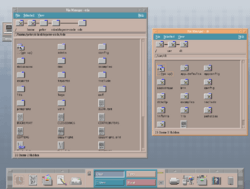Common Desktop Environment facts for kids
 |
|

|
|
| Developer(s) | The Open Group (early), CDE Project (modern) |
|---|---|
| Stable release |
2.2.2 / July 27, 2014
|
| Operating system | Unix, Linux, BSD, OpenVMS, other Unix-like OSes |
| Type | Desktop environment |
| License | LGPL v2+ |
The Common Desktop Environment (CDE) is a desktop environment for Unix and OpenVMS, based on the Motif widget toolkit. It was part of the UNIX98 Workstation Product Standard, and was long the "classic" Unix desktop associated with commercial Unix workstations.
After a long history as proprietary software, CDE was released as free software on 6 August 2012, under the GNU Lesser General Public License, version 2 or later. Since its release as free software, CDE has been ported to Linux and BSD derivatives.
Early development
Hewlett-Packard, IBM, SunSoft, and USL announced CDE in June 1993 as a joint development within the Common Open Software Environment (COSE) initiative. Each development group contributed its own technology to CDE:
- HP contributed the primary environment for CDE, which was based on HP's Visual User Environment (VUE). HP VUE was itself derived from the Motif Window Manager.
- IBM contributed its Common User Access model from OS/2's Workplace Shell.
- Sun contributed its ToolTalk application interaction framework and a port of its DeskSet productivity tools, including mail and calendar clients, from its OpenWindows environment.
- USL provided desktop manager components and scalable systems technologies from UNIX System V.
Images for kids
-
Reading Linux kernel man pages in CDE
See also
 In Spanish: Common Desktop Environment para niños
In Spanish: Common Desktop Environment para niños





